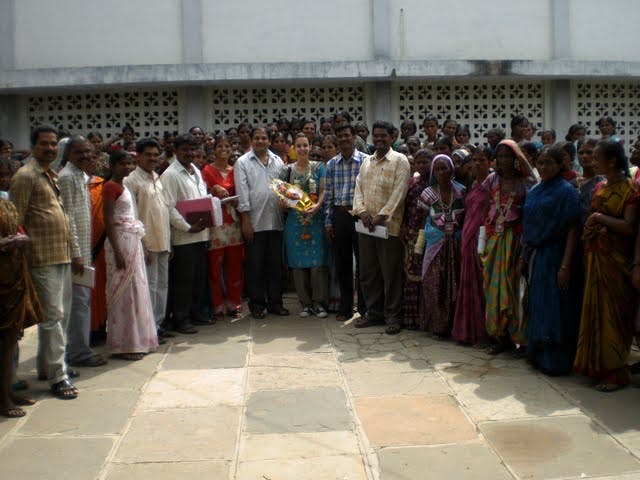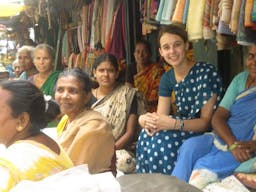150 widows in Khammam!
Jan 21, 2015
First story


As I made my way into the meeting hall on the Diocese compound I expected to find fifteen to twenty local widows waiting for me...the Diocese had informed me prior to my arrival that they had invited only women in a 2KM radius of the compound and that they only expected that many to show up. I saw three rickshaws outside and had assumed they were for some other meeting going on in the hall (I would soon find out how many women had piled in them to come to the meeting)...as I made my way to the second story I saw about twenty women sitting in the hall. I thought they were waiting to enter the room until myself and the pastor running the program arrived, but as I entered the room I saw every chair and standing space available had been filled by women. There were easily one hundred women filling this room. I was seated at the front in a plastic chair by the Bishop and pastor assisting me. The Bishop began to ask how many women were widows and where some of them were from...he had assured me that any woman supported by WEI from this meeting would be creditable (I think this was his way of showing me that these women were not just brought in to fill the room). As I sat overwhelmed wondering how I could possibly interview each and every one of these women, the Bishop and his staff presented me with a bouquet and a flower garland for my neck. They said that the women wanted to thank me for coming and meeting with them. After these formal greetings we started our interviews with the women.
Up to this point in my trip, I have met with every widow individually but how could I possibly do that with over one hundred people. The meeting began in a very disorderly fashion as no one expected that many people...we tried to call each widow up individually and have the pastor translate for me but it was taking way too long. I suggested we hand out the surveys and then just translate what the questions were and have the widows fill in the answers but the pastor informed me that they were illiterate and could not write in Telugu (the language of Andhra Pradesh), let alone English. The pastor then called in reinforcements (people who could translate and write in English) to help with the interviews. With this help we were able to form an assembly line of sorts...myself (with an interpreter of course), another man, and the pastor would interview women then send them out to the hall for their pictures. I was somewhat sad that I was not able to meet with every widow individually as I lost that personal connection that I had with the widows in Kerala. At this point I had no choice...I was not about to send half of these women home and ask them to come back tomorrow. Soon after we got the assembly line working like a well oiled machine the current (electricity) cut out...not an unfamiliar occurrence in India. In a room full of one hundred plus women, without power, on a day more hot and humid than any day I have ever experienced, we almost melted as we worked feverishly to speak with every woman. The women were so excited they would come up and crowd around me like the children at the orphanages had. You could see the hope and belief in me in every one of their eyes. Some were widows of farmers like those in Kerala but many had husbands die from illness, lightning, accidents, etc. As we went through the interviews many women wanted goats, sheep, petty shops, etc. A few had very original ideas such as making leaf plates for the local hotels (hotel=restaurant in India and lodge=hotel where you sleep). As we continued to melt away in the heat women began taking turns fanning me...I tried to make them stop because it was ridiculous that they would stand and work harder than they had to in that weather and I definitely did not deserve such treatment but they insisted. Once one woman got to the point her arm almost fell off another would replace her. As we progressed through the interviews more women would enter. At first I did not realize it because the room was so big but three hours into the interviews I wondered why the room was not emptier, especially because I had told the pastor to let the women leave after they had been interviewed. Finally, at 3:00pm the pastor asked me to take a break for lunch...I struggled with this as there were still at least thirty women to talk to and they had waited all day without eating anything. At last I agreed as I thought the food might replace some of the ten pounds I had sweated out in the proceeding hours.
As we made our way to lunch I found the women we had interviewed waiting in the hall...they had all waited so that they could personally thank me as I headed out. I could not believe that these women had subjected themselves to sitting outside in the heat just to bow their heads at me in thanks. I insisted they all come down and take a picture with me as I did not want to forget a single person I had met with. After pictures I took my lunch break and hurried back to finish more interviews. Some of the pastor's assistants had continued with the interviews while we were at lunch and there were about twenty people left when we returned. Some men had even shown up asking for assistance. Most of the people left were tribal women. These women do not dress in the traditional saree like most Indian women...they wear very vibrant and full skirts, shirts that resemble halter tops that are done in patchwork like quilts, and bracelets from their wrists to elbows. The bracelets appear to be made out of a pvc pipe material and make the women appear to have white plastic sleeves until they move their arms and you can see each individual bracelet separate. They are very interesting because they speak their own language and live separately from the people of Khammam. I was told by the pastor that many many years ago these people came to India and were considered "untouchables" even beyond those that were untouchable in the Hindu caste system. They were sent out to live where no one else would and developed their own languages and clothing styles. They have curly hair and different facial features that those of other Indians. They talk much louder and often scream in comparison to the soft spoken Indian women of the city. Finally we were done with our last interview and I made my way to leave as I was pulled aside by multiple widows who had waited in the hallway to take their picture with me. I was so honored by their unconditional love for a foreigner who could offer them nothing at this point in time. Some of them had walked 2KM to answer questions for me, hadn't eaten maybe in days, and then waited in the hall for a photo!
Once the meeting was over I was rushed back to the Bishop's house to clean up and go visit a few more of the orphanages run by the Diocese. I even got to meet with the head of the Diocese micro-finance program for a few minutes. He is a young Italian man who knows a lot about finance and has been involved in Indian micro-finance for the last three years. It was really neat to meet someone who shared my same passion and had already been where I am. After eating at one of the orphanages we returned to the Bishop's house where I straight to sleep to prepare for my trip to Rajahmundry the next morning...
India tip of the day: Get your bug spray in India!
New pictures from my meeting in Khammam can be found at: http://picasaweb.google.com/Heather.Lee.Murphy/Khammam




